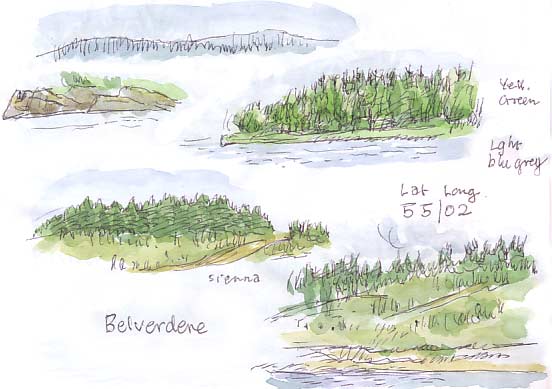
Richard Bell's Nature Diary, Northumberland, Wednesday, 14th July 2010

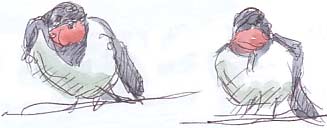 WE'RE
STAYING in The Brown Room at the Holly Bush so it's not surprising that this
morning, when I left my brown art bag in the corner on the brown carpet in front
of the brown curtains, I omitted to pick it up when I grabbed the stuff we needed
for our day out, so at the Tower Knowe visitor centre at Kielder
Water I bought a little sketchbook and the assistant kindly presented me with
black ballpoint pen. As I drew the view from The Osprey, the electric-powered
ferry, I scribbled colour notes of the sort which probably wouldn't mean much
to anyone else but which triggered the memories of the colours for me. I added
the watercolour later, when I'd been reunited with the bag that I habitually
take almost everywhere with me.
WE'RE
STAYING in The Brown Room at the Holly Bush so it's not surprising that this
morning, when I left my brown art bag in the corner on the brown carpet in front
of the brown curtains, I omitted to pick it up when I grabbed the stuff we needed
for our day out, so at the Tower Knowe visitor centre at Kielder
Water I bought a little sketchbook and the assistant kindly presented me with
black ballpoint pen. As I drew the view from The Osprey, the electric-powered
ferry, I scribbled colour notes of the sort which probably wouldn't mean much
to anyone else but which triggered the memories of the colours for me. I added
the watercolour later, when I'd been reunited with the bag that I habitually
take almost everywhere with me.
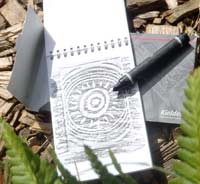

Realising we were interested in that kind of thing, the assistant
suggested we might be interested in the Kielder Keepsake (left),
a rubbing notepad, complete with chunky black wax crayon, with a map of a trail
around Bull Crag Peninsula. On the walk there are 12 different bronze rubbing
plaques, designed by Nicola Moss in 1998. It added another
dimension to the walk, although we'll have to come back some time as we missed
several plaques.
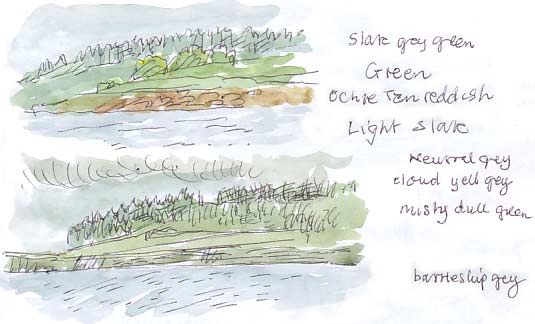
After sailing past 'slate grey green' conifer plantations' and
'ochre tan reddish' shorelines across the sparkling 'light slate' waters, we
arrived at Leaplish to walk the 8 miles back to Tower Knowe
along the shore-side path via Bull Crag Peninsula.
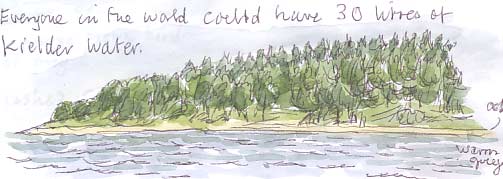

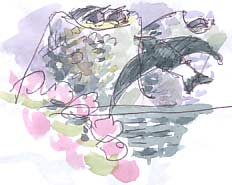 House
martins (right) and swallows nested under
the eaves of the visitor centres and siskins were regular visitors to the bird
feeders but the bird highlight of our walk was a pair of crossbills.
The male looked like a little parrot with bronze red plumage as he perched on
the top of a conifer but then Barbara spotted that the female was feeding close
to us by the edge of the path. Apart from a greenish patch on her rump she was
remarkably grey – as if she'd been primed with undercoat. The female in
the bird book looks greener and more speckled than the impression we got of
smooth greyness when observing her in real life at close quarters but the descriptions
point out that the plumage of individual crossbills can vary.
House
martins (right) and swallows nested under
the eaves of the visitor centres and siskins were regular visitors to the bird
feeders but the bird highlight of our walk was a pair of crossbills.
The male looked like a little parrot with bronze red plumage as he perched on
the top of a conifer but then Barbara spotted that the female was feeding close
to us by the edge of the path. Apart from a greenish patch on her rump she was
remarkably grey – as if she'd been primed with undercoat. The female in
the bird book looks greener and more speckled than the impression we got of
smooth greyness when observing her in real life at close quarters but the descriptions
point out that the plumage of individual crossbills can vary.


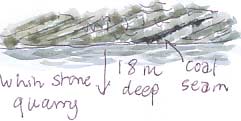 We
got a brief view of an osprey as the ferry neared the far side
of the lake; a brown bird with a wingspan of almost 6 feet with distinctly angled
wings.
We
got a brief view of an osprey as the ferry neared the far side
of the lake; a brown bird with a wingspan of almost 6 feet with distinctly angled
wings.
The pre-recorded commentary on the ferry pointed out a low cliff which is all that now shows above water of the quarry from which much of the Whin Stone used in the construction of the dam was taken.
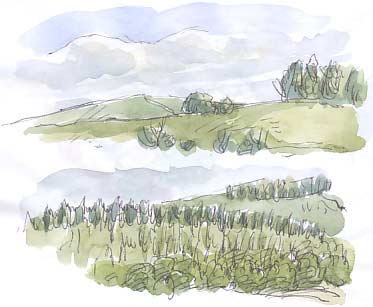 I
have to record that this relaxing walk in England's most tranquil location was
somewhat marred by Barbara cheating at 'pooh-sticks'. Well, OK, not cheating
exactly, but, like Darren Brown, using psychology and misdirection to win; she
went off and picked up a couple of sticks and gave me the choice, knowing
that I'd go for the larger one which was forked and shaggy with moss and lichen.
I'd already worked out that the turbulent water on the outside bend of the little
river indicated the fastest current but the result was that while Barbara's
slim no-nonsense stick soon bobbed up in the frothy brown water on the downstream
side of the bridge, mine was still whirling around in ever decreasing circles
in a whirlpool.
I
have to record that this relaxing walk in England's most tranquil location was
somewhat marred by Barbara cheating at 'pooh-sticks'. Well, OK, not cheating
exactly, but, like Darren Brown, using psychology and misdirection to win; she
went off and picked up a couple of sticks and gave me the choice, knowing
that I'd go for the larger one which was forked and shaggy with moss and lichen.
I'd already worked out that the turbulent water on the outside bend of the little
river indicated the fastest current but the result was that while Barbara's
slim no-nonsense stick soon bobbed up in the frothy brown water on the downstream
side of the bridge, mine was still whirling around in ever decreasing circles
in a whirlpool.
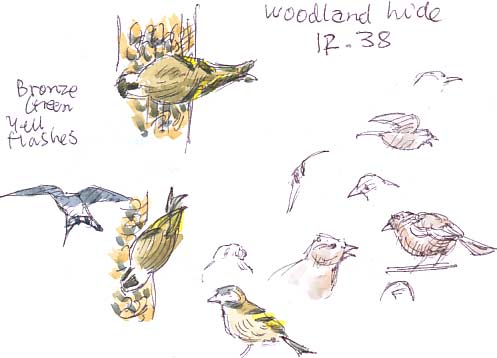
We weren't lucky enough to see red sqirrels at the Squirrel Hide near Leaplish but it was worth taking a break there to sketch the siskins (above). Back at Tower Knowe there was another chance to sketch birds from our table by the window in the café, right next to the bird feeders.
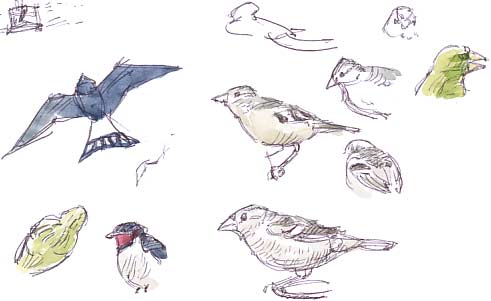
You can see the disadvantage of adding the colour later in these sketches; I've given the swallow the white rump of house martin!
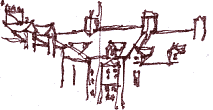 I
think we'll be heading for Kielder again before too long but our short break
was over too soon and on the Thursday we headed back across the North Pennines,
via Alston and High Force, pausing only for a coffee stop at Middleton-in-Teesdale
(left), before joining the A1 at Scotch Corner for the last leg of
our return journey.
I
think we'll be heading for Kielder again before too long but our short break
was over too soon and on the Thursday we headed back across the North Pennines,
via Alston and High Force, pausing only for a coffee stop at Middleton-in-Teesdale
(left), before joining the A1 at Scotch Corner for the last leg of
our return journey.